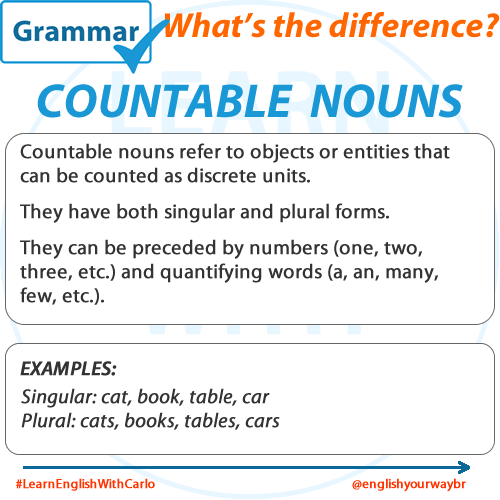Countable and uncountable nouns are two categories used to classify nouns based on whether they can be counted or not.

Countable Nouns:
Countable nouns refer to objects or entities that can be counted as discrete units.
They have both singular and plural forms.
They can be preceded by numbers (one, two, three, etc.) and quantifying words (a, an, many, few, etc.).
Examples:
Singular: cat, book, table, car
Plural: cats, books, tables, cars
Countable nouns can be counted individually or as a group.

Uncountable Nouns (Mass Nouns):
Uncountable nouns refer to substances, concepts, or qualities that cannot be counted as individual units.
They usually don’t have a plural form or can’t be pluralized without changing their meaning.
They cannot be preceded by numbers or quantifying words like “a” or “an.”
Examples:
water, rice, information, furniture
Uncountable nouns are often measured or quantified by using units of measurement, containers, or other quantifying expressions:
a bottle of water, a cup of rice, a piece of information
Here’s a comparison to illustrate the difference:

UNCOUNTABLE NOUNS ARE OFTEN:
Abstract Ideas: love, freedom, education, luck, help, music, beauty
Made of small parts: rice, sugar, sand, flour, dirt, dust, traffic, grass, spaghetti
Some food: bread, fish, cheese, chocolate, ham, bacon, food, meat
Liquids and Gases: water, coffee, milk, oil, rain, soup, air, smoke, fog, blood
Materials: wood, glass, paper, gold, silver, ice, steel, cotton, wool

Countable: “I have three cats.”
Here, “cats” is countable because you can count each individual cat.
Uncountable: “I need some advice.”
“Advice” is uncountable because you can’t count it as individual pieces of advice; it’s a concept rather than a physical object.
Remember, some nouns can be both countable and uncountable depending on context. For example, “fruit” is usually uncountable (as in “I like fruit”), but it can be countable when referring to specific types of fruit (as in “I bought three fruits: an apple, a banana, and an orange”).
